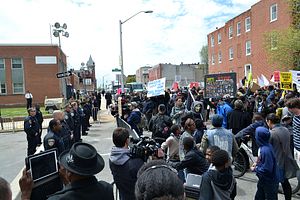Last month, People’s Daily published an argument that the Baltimore riots and other recent ethnic conflicts “expose the institutional fragility of American society.” Yes, the riots in Baltimore underscore the city’s economic inequality and public violence sparked by police killings of unarmed African Americans is a chronic problem. However this is the epitome of what Chinese call wuya xiao zhu hei (the crow laughing at the black pig), or the pot calling the kettle black. It also points to an old misunderstanding that dates back to before the PRC even existed.
When the Scottsboro boys were sentenced to death in 1931, the Soviet propaganda artist Dmitry Moor produced a poster that read, “Freedom to the prisoners of Scottsboro!” Soon Americans who criticized the Soviet Union for its human rights violations were answered with the famous tu quoque argument: “A u vas negrov linchuyut” (and you are lynching Negroes). This expressed the communist belief in equality but also served to delegitimize Western capitalist powers, as seen by Mao’s many relevant statements, including his 1963 “Statement Supporting the American Negroes In Their Just Struggle Against Racial Discrimination by U.S. Imperialism.”
Mao’s support wasn’t a one-way street, either. Civil rights leaders in America also identified with China’s struggle. In his autobiography, Malcolm X described “the white man’s fear and tension concerning China.” In a 1959 speech to Peking University students, W.E.B. Du Bois addressed his distant African brothers and sisters, saying, “China is flesh of your flesh and blood of your blood. China is colored, and knows to what the colored skin in this modern world subjects its owner.”
Communism, it was believed, was the key to racial equality. In The Autobiography of LeRoi Jones, the poet and Maoist ideologue Amiri Baraka wrote, “When the Chinese exploded their first A-bomb I wrote a poem saying, in effect, that time for the colored peoples had rebegun.” Some believers even moved to China. Black Like Mao: Red China and the Black Revolution recounts Vicki Garvin’s time there from 1964 to 1970, where she edited English translations of the Peking Review. The book also mentions Maoist activist Huey Newton, co-founder of the Black Panther Party, who visited China in 1971 and later said he had “felt absolutely free for the first time.” However, considering he believed the Huns to be the ethnic majority group, it doesn’t seem his understanding of China ran very deep. Du Bois romanticized China even further, and in so doing exhibited an even deeper ignorance. According to Edward J. Blum’s W.E.B. Du Bois, American Prophet, the Brooklyn professor once said of China: “their officials are incorruptible, their merchants are honest.”
One wonders what Newton or Du Bois would’ve made of the 1988 anti-African protests in Nanjing, where 300 Hohai University students broke into the African dorms, locked occupants inside, and set the building on fire. Within a day, the anti-African protest was 3,000 strong. Or the incident in Kunming in 2013, when a dispute between an African-American and a street vendor ended with the American hiding in a Western restaurant and an angry mob yelling racist death threats and throwing bottles at patrons. Or the 2009 and 2012 protests by Guangzhou’s African community, which began after Africans died fleeing police or in police custody. Or the practice, documented in The East Is Black: Cold War China in the Black Radical Imagination, of creating white supremacist groups in prison camps during the Korean War in order to demoralize African-American soldiers.
In a 2010 talk at Sichuan University Joe Lockard, an antislavery scholar and English professor at Arizona State University, explained that despite shared principles, both sides failed to see that their opponents — imperialists and white supremacists — were not the same. Du Bois and others believed in a chimerical China and leapt into a revolution they did not understand.
“While his Chinese hosts took an interest in the U.S. civil rights movement,” Lockard told me this week, “they did not view it as applicable to China or its minorities. The DuBoisian concepts of double consciousness and The Veil, which became common means of explaining minority-majority relations in the United States, remained unknown in China. Du Bois was a convenient and willing political symbol, no more.”
The great miscalculation was witnessing China’s persecution and concluding that “China is colored.” Actually, given the treatment of its own minorities and the government’s incredible power, it might be more accurate to say that the Han is the white man of Asia.
As evidenced by the People’s Daily piece, China still uses ethnic conflict to attack America — but it doesn’t take similar criticism very well. The Ghulja, Hotan, Qaraqash, Shaoguan and Urumqi ethnic riots come to mind. Imagine the outraged reaction if the United States rebutted China’s critiques by saying, “And you are killing Uyghurs.”

































